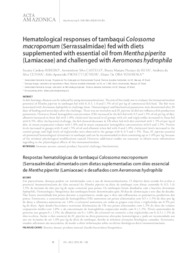Hematological responses of tambaqui Colossoma macropomum (Serrassalmidae) fed with diets supplemented with essential oil from Mentha piperita (Lamiaceae) and challenged with Aeromonas hydrophila.
Hematological responses of tambaqui Colossoma macropomum (Serrassalmidae) fed with diets supplemented with essential oil from Mentha piperita (Lamiaceae) and challenged with Aeromonas hydrophila.
Author(s): RIBEIRO, S. C.; CASTELO, A. S.; SILVA, B. M. P. da; CUNHA, A. da S.; PROIETTI JÚNIOR, A. A.; YOSHIOKA, E. T. O.
Summary: In fish farmings, diseases can be reduced by using immunostimulants. The aim of this study was to evaluate the immunostimulant potential of Mentha piperita in tambaqui fed with 0, 0.5, 1.0 and 1.5% of oil per kg of commercial fish feed. The fish were inoculated with Aeromonas hydrophila to challenge them. Hematological and biochemical parameters were determined after 30 days of feeding and seven days after the challenge. There was no mortality and M. piperita oil did not influence fish production parameters. However, blood hemoglobin concentration (Hb) increased in the fish fed with 0.5 and 1.5% of oil per kg of diet; albumin increased in those fed with 1.0%; cholesterol increased in all groups with oil; and triglycerides increased in those fed with 0.5%. After the bacterial challenge, the fish showed decreases in Hb when fed with diet enriched with 1.5% oil per kg of diet, in mean corpuscular volume with 1.0% and in mean corpuscular hemoglobin concentration with 0 and 1.5%. Protein levels increased in groups with 0 and 1.5% of oil and albumin when fed with 0 and 1.0%; cholesterol levels increased in the control group; and high levels of triglycerides were observed in the groups with 0, 0.5 and 1.5%. Thus, M. piperita essential oil promoted hematological alterations in tambaqui and can be recommended in diets containing up to 1.0% per kg, because of the minimal physiological modifications caused. However, additional studies are necessary to obtain more information regarding to the physiological effects of this immunostimulant.
Publication year: 2016
Types of publication: Journal article
Unit: Embrapa Amapá
Observation
Some of Embrapa's publications are published as ePub files. To read them, use or download one of the following free software options to your computer or mobile device. Android: Google Play Books; IOS: iBooks; Windows and Linux: Calibre.
Access other publications
Access the Agricultural Research Database (BDPA) to consult Embrapa's full library collection and records.
Visit Embrapa Bookstore to purchase books and other publications sold by Embrapa.

